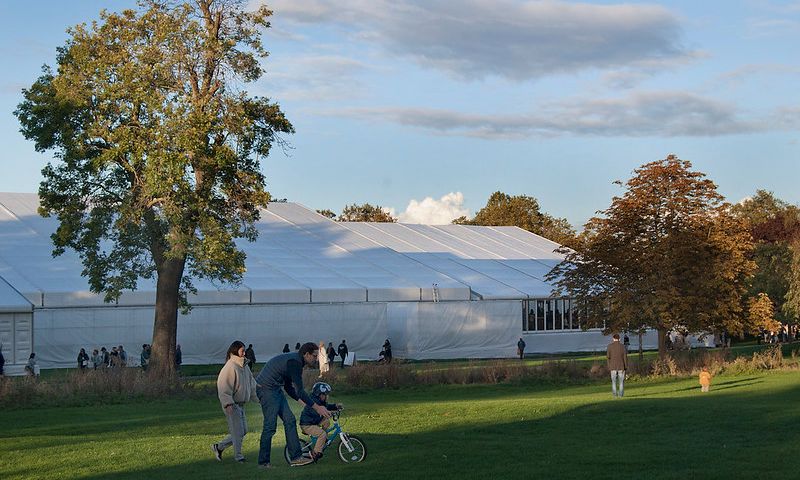The participating fairs, including Frieze, have committed to working towards near zero waste
Photo by Lyndon Douglas. Courtesy Frieze / Lyndon Douglas Photography
In this monthly column, Louisa Buck looks at how the art world is responding to the environmental and climate crisis.
It’s a well-known fact that the environmental impact of art fairs is a hefty one. In any conversation around making our sector more sustainable, these notoriously energy- and resource-hungry events are invariably cited as the number one baddies, combining pretty much all elements of polluting art world activity—energy generation, shipping and international travel, booth construction and art packaging—under one (often custom-built) roof.
But now in an unprecedented initiative, some of the most fiercely competitive of fair franchises are coming together in what appears to be a genuine attempt to green up their act. Frieze, Art Basel and Tefaf are among more than 40 art fairs worldwide which have joined forces in a unified pledge to cut their emissions by at least 50% by 2030. They have also committed to working towards near zero waste.
And it’s not just about the big events: smaller fairs such as Copenhagen’s Chart and the new Stage fair in Bregenz are also among the signatories. This groundbreaking alliance was launched during Climate Week in New York last month and was the result of more than a year of behind-the-scenes discussions and negotiations, brokered by the international environmental charity Gallery Climate Coalition (GCC), which I co-founded.
“There’s no competition when it comes to the climate emergency,” says GCC director Heath Lowndes. He adds that while art fairs may not be directly responsible for all the emissions and pollution generated by those taking part, she feels that as hosts to both galleries and their collectors they nonetheless have a shared responsibility to encourage exhibitors to reduce their environmental impact.
Tefaf Maastricht 2024. Fairs such as Tefaf have signed a “co-commitment statement" which declares that they “have a responsibility not only to urgently reduce our own impact on the planet, but also to use our platforms to encourage others in our networks to do the same.”
Photo: Loraine Bodewes. Courtesy of TEFAF
This sentiment is echoed in a joint “co-commitment statement” issued by the new consortium of fairs, which declares: “art fairs have a common mission to promote art in all its forms, to inspire audiences and to support galleries and artists in thriving—as the climate crisis endangers this mission, we have a responsibility not only to urgently reduce our own impact on the planet, but also to use our platforms to encourage others in our networks to do the same.”
They certainly do. While art fairs may argue that they provide a one-stop shop for collectors that prevents even more globe-trotting, recent research by GCC confirms that for a typical mid-size commercial art gallery, one third of its annual carbon emissions relates to its activities around art fairs. Air travel—both of artworks and people—carries the heaviest footprint, taking up about 70% of the overall total.
The fairs generate specific issues of their own, including a high rate of single-use materials, such as carpets and stud-walls, and enormous energy consumption. And this is ramped up even more when a fair occupies a temporary rather than an already existing structure.
All of the issues mentioned so far, and many more, are comprehensively addressed in the GGC’s Art Fair Toolkit for Environmental Responsibility, which has been developed in partnership with environmental experts as well as with the alliance of art fairs. Participants in the new fair group have made using this toolkit and implementing its proposed actions in every aspect of their operations one of the key pledges set out in their “co-commitment statement”.
The toolkit, available on the GCC website, leaves no aspect of art fair activities unscrutinised, offering a detailed “road map” of clear, actionable steps specifically tailored to enabling art fairs to make significant and wide-reaching changes across their operations. These range from switching to renewable energy suppliers to encouraging shippers to offer exhibitors consolidated or sea freight options, or establishing “green teams” dedicated to implementing environmental responsibility.
They also include implementing a raft of nitty gritty practicalities, from biodegradable alternatives to vinyl wall texts, and working with sustainable suppliers of everything from paint and carpet to toilet rolls.
“The establishment of this toolkit marks a significant step forward and offers us invaluable guidance,” states Frieze’s chief financial and operations officer Jon Ashman. Tefaf’s head of fairs Will Korner, meanwhile, is also keen to flag up a number of“working plans for the recycling and reuse of hard and soft building materials and packaging” to be implemented at the next edition of the fair as well as new strategies around “catering, staff travel, and the overhaul of logistical practices, among others.”
But while this inter-fair alliance marks a pivotal moment for environmental responsibility within the industry, it also flags up just how much still needs to be done. Many more fairs were approached to join and for whatever reason did not respond. Let’s see if the fact that some of the biggest fair behemoths have been prepared to stand up and be counted will make them change their minds.
Meanwhile, those who have formed this radical new alliance also must not be allowed to rest on their laurels. Serious systemic changes need to take place, and fast, to convince the doubters that this new road map is not just a high profile greenwash.
A good start would be for Art Basel to terminate its 23-year partnership with the private aviation company Netjets, the company which rents and sells luxury aircraft to the super-rich. Flying in a private jet is considered to be probably the most polluting activity that a singleindividual can carry out. Grounding this most toxic of relationships would send out a clear signal to fairs, gallerists and collectors alike that the art world is genuinely entering a cleaner, greener era.

